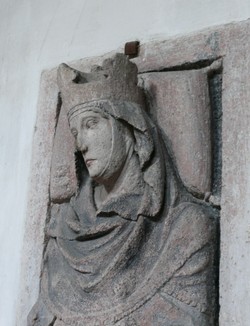Hemma facts for kids
Quick facts for kids Emma of Altdorf |
|
|---|---|

Tomb effigy at St. Emmeram's Abbey
|
|
| Queen consort of the Franks East Frankish queen |
|
| Tenure | 843–876 |
| Born | c. 803 |
| Died | 31 January 876 Regensburg |
| Spouse | Louis the German (m. 827) |
| Issue more... |
Louis the Younger Irmgard of Chiemsee Carloman of Bavaria Charles the Fat |
| House | Welf |
| Father | Welf of Altdorf |
| Mother | Hedwig of Saxony |
Emma of Altdorf, also known as Hemma (born around 803 – died 31 January 876), was an important queen in the early history of Germany. She was a member of the powerful Elder House of Welf family. She became the first Queen consort of East Francia (an early form of Germany) when she married King Louis the German. She held this title from 843 until her death.
The Life of Queen Emma
Emma's father was Welf I, a count from a place called Altorf. Her mother was Hedwig. Emma had an older sister named Judith. Judith married the Carolingian emperor Louis the Pious in 819. This made Judith the Queen of the Franks and a Holy Roman Empress. This marriage was a big step for the Welf family, helping them become more powerful.
In 827, Emma married Louis the German. He was the youngest son of Emperor Louis the Pious. It is thought that Emma's sister, Judith, might have helped arrange this marriage. The wedding likely took place in Regensburg, a city in Germany. At that time, Louis the German was the King of Bavaria, a region under his father's rule. In 833, Emma received Obermünster Abbey in Regensburg from her husband. An abbey is a type of monastery, a place where monks or nuns live.
Emperor Louis the Pious died in 840. After his death, there were many struggles among his sons over who would rule. Eventually, the large Carolingian Empire was divided into three parts by the Treaty of Verdun in 843. Louis the German received the eastern part, which became known as East Francia. This kingdom is seen as the beginning of modern Germany. With this, Emma became the first Queen of East Francia.
Historical records do not mention Emma very often. It seems she did not have a lot of direct influence on her husband's decisions as king. However, some historical writings suggest she was very proud. One source, the Annales Bertiniani, written by Archbishop Hincmar of Reims, mentioned that her pride displeased the people of Italy. It is also said that she strongly favored her son Carloman. Carloman was chosen to inherit his father's lands in Bavaria. This favoritism reportedly caused disagreements with his brothers.
In 874, Emma suffered a stroke, which left her unable to move or speak. King Louis visited her for the last time in 875. She passed away on January 31, 876, just a few months before her husband. Emma was buried in St. Emmeram's Abbey in Regensburg. Her tomb, which was built around the year 1300, is considered a beautiful example of medieval art.
Royal Family
Emma and Louis the German had eight children together:
- Hildegard (827–856)
- Carloman (828–880)
- Ermengard (around 830-866)
- Gisela, who married Berctolf, a count from Swabia. She was the grandmother of Cunigunde of Swabia.
- Emma
- Louis the Younger (830–882)
- Bertha (died 877)
- Charles the Fat (839–888)
Three of their sons later became kings. Three of their daughters became nuns, dedicating their lives to religious service.

